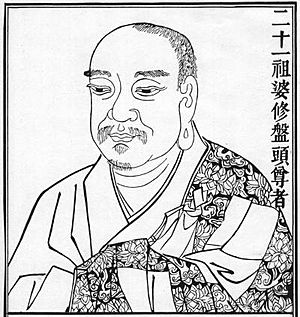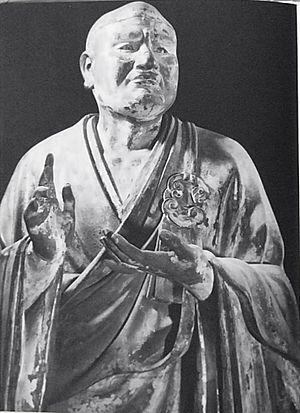Vasubandhu facts for kids
Quick facts for kids
Vasubandhu
|
|
|---|---|

Gandharan monk and Yogacara philosopher Vasubandhu as Chan patriarch in a Chinese illustration.
|
|
| Occupation | Buddhist monk |
| Known for | Cofounder of the Yogacara philosophical school. |
Vasubandhu (traditional Chinese: 世親; ; pinyin: Shìqīn; Devanagari: वसुबंधु; Tibetan: དབྱིག་གཉེན་ Wylie: dbyig gnyen; lived around the 4th to 5th century CE) was a very important Buddhist monk and thinker from ancient India. He was born in a place called Puruṣapura, which is now Peshawar in Pakistan.
Vasubandhu was a philosopher who wrote about Buddhist ideas, especially from the Sarvastivada and Sautrāntika schools. Later, he became a follower of Mahayana Buddhism. With his half-brother, Asanga, he helped start the Yogacara school of Buddhist thought.
One of Vasubandhu's most famous books is Abhidharmakośakārikā. This book is still widely used in Tibetan and East Asian Buddhism. His ideas about "appearance only" (vijñapti-mātra) were very important for the Yogacara school. This idea is about how everything we experience appears in our minds.
Vasubandhu is seen as one of the most important thinkers in Buddhist history. In some Buddhist traditions, he is considered a very special teacher or "patriarch."
Contents
Life of Vasubandhu
Vasubandhu was born in Puruṣapura, in the Gandhara region of ancient India. His half-brother, Asanga, was also a key person in starting the Yogacara philosophy. Vasubandhu's name means "the Kinsman of Abundance." He and Asanga are known as two of the "Six Ornaments," which means they were great teachers of the Buddha's ideas.
Vasubandhu first studied with the Sarvastivada Buddhist school. This school was very strong in Gandhara. Later, he went to Kashmir to learn from the main teachers of the Sarvastivada school there.
After returning home, he taught about a part of Buddhist philosophy called Abhidharma. He wrote his famous book, Abhidharmakośakārikā, which explains the Sarvastivada teachings. However, Vasubandhu also started to have questions about some of the Sarvastivada ideas. He then wrote another book that looked at their ideas from a different viewpoint, called the Sautrāntika school.
Later, his brother Asanga helped him learn about Mahayana Buddhism. Vasubandhu then wrote many more books about Yogacara ideas and Mahayana teachings. Some of his most important works include the "Twenty Verses on Consciousness Only" and the "Thirty Verses on Consciousness-only."
Vasubandhu became a famous Mahayana master and debater. He was known for winning arguments against other philosophers. He used the money he earned to build Buddhist monasteries and hospitals. It is said that Vasubandhu died in Nepal when he was 100 years old.
Vasubandhu's Writings
Vasubandhu wrote many books and essays on Buddhist topics. Some of his other important works include:
- A Treatise on Karma (Karmasiddhiprakarana)
- Rules for Debate (Vādavidhi)
- Instruction on the Amitabha Sutra (Amitayus sutropadeśa)
- Discourse on the Pure Land
- Treatise on Consciousness only (Vijnaptimatrata Sastra)
- Commentaries on important Buddhist texts like the Diamond Sutra and the Lotus Sutra.
One or Two Vasubandhus?
For a while, some scholars thought there might have been two different people named Vasubandhu. One would have written the earlier works, and the other the later Mahayana texts. However, most experts today believe there was only one Vasubandhu. They think his ideas simply grew and changed over time, which is clear when you read his different writings.
Vasubandhu's Philosophy
Vasubandhu's ideas were very deep and shaped Buddhist thought for centuries.
Understanding Abhidharma
Vasubandhu's book, Verses on the Treasury of the Abhidharma, describes 75 "dharmas." These are like the basic building blocks or events that make up all experience. The book also explains the Sarvastivada teachings, including how to meditate, ideas about the universe, how we see things, and how karma works. In his commentary on this book, Vasubandhu also questioned some of the Sarvastivada ideas. For example, he argued against the idea of a Creator God.
No Permanent Self
One of Vasubandhu's main ideas was about the "self." He argued that there is no permanent, unchanging "self" or "soul" that exists on its own. This is a core Buddhist teaching called Anatman.
Vasubandhu said that what we call "self" is just a collection of constantly changing parts, like our body, feelings, thoughts, and consciousness. He used logic to show that we can't find a separate "self" through our senses or by thinking. He believed that thinking of a "self" as something separate and real causes suffering.
He also explained how karma works without a fixed self. He said that it's a continuous flow of actions and their results that carries on, not a "self" that moves from one life to the next.
Everything is Changing
During Vasubandhu's time, Buddhist philosophers debated about time. The Sarvastivada school believed that things exist in the past, present, and future. But Vasubandhu, following the Sautrāntika school, argued for "momentariness." This means that each moment, each "dharma" or event, comes into being, does its job, and then disappears. Our experience is like a fast-moving series of these momentary events.
He explained how karma continues even with this idea of momentariness. He talked about a "storehouse consciousness" (ālayavijñāna). This is like a special part of our mind that stores the "seeds" of our actions and experiences, allowing them to continue and lead to future results, even across different lives.
Yogacara: Appearance Only
Vasubandhu's main Yogacara works explain the idea of "vijñaptimātra," which means "appearance only" or "consciousness-only." This idea suggests that everything we experience, think about, or are aware of, happens only within our consciousness. It's not that external things don't exist at all, but that they appear to us through our minds.
He used the example of dreams to explain this. In a dream, things seem real and solid, even though they are just in our minds. He also used the example of mass hallucinations (like in Buddhist hell stories) to show how mental appearances can be shared by many people.
Vasubandhu also talked about the Eight Consciousnesses in the Yogacara theory. He explained how these different types of consciousness can be changed as a person moves through the stages of enlightenment. The goal is to turn ordinary consciousness into pure, direct understanding.
Three Natures of Experience
Vasubandhu also taught about the "three natures" or "three ways" that we experience things.
- Fabricated nature: This is our everyday world, full of appearances and mental ideas. It's how we usually see things.
- Dependent nature: This is the process that causes the fabricated nature to appear. It's how things come into being based on causes and conditions.
- Absolute nature: This is reality as it truly is, without any separation between the observer and what is observed. It's a non-dual state.
Vasubandhu used the example of a magician. The magician uses a spell (dependent nature) to make a piece of wood (the absolute nature) look like an elephant (fabricated nature). The problem for us is that we get fooled by the illusion and think the elephant is real. True wisdom is seeing through this illusion and understanding that the "self" and the idea of separate things are not truly real.
Logic and Debate
Vasubandhu was also important for developing Buddhist logic. He was very interested in how to make arguments perfect and clear, especially for philosophical debates. His work on logic helped set the stage for later Buddhist thinkers in this field.
Works
- Abhidharma Kosha Bhashyam translated into English by Leo Pruden, Asian Humanities Press, Berkeley, 1988-90.
- Stefan Anacker, Seven Works of Vasubandhu Motilal Banarsidass, Delhi, 1984, 1998
See also
 In Spanish: Vasubandhu para niños
In Spanish: Vasubandhu para niños


